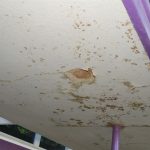Water damage to ceilings can be a frustrating and expensive issue for homeowners to deal with. Whether it’s the result of a leaky roof, burst pipes, or other water-related incidents, the consequences of ceiling water damage can range from unsightly stains to structural compromises. The good news is that in many cases, homeowner’s insurance can provide coverage for such damages. However, understanding the intricacies of insurance coverage for ceiling water damage is crucial to ensuring a smoother claims process and avoiding potential financial pitfalls. In this article, we’ll explore what you need to know about insurance coverage for ceiling water damage.
Types of Insurance Policies
Before delving into the details of insurance coverage, it’s important to know that there are different types of insurance policies that homeowners might have. The most common ones include:
- Homeowner’s Insurance: This policy generally covers damages caused by sudden and unexpected events, such as burst pipes, water heater leaks, or roof leaks. It typically does not cover damages resulting from gradual wear and tear or neglect.
- Flood Insurance: Standard homeowner’s insurance does not cover flooding, so homeowners who live in flood-prone areas might need a separate flood insurance policy to cover damages from floods or heavy rain.
- Renter’s Insurance: If you’re a tenant, your belongings might be covered under renter’s insurance in case of ceiling water damage, but the landlord’s insurance would typically cover the structural repairs.
Covered vs. Non-Covered Scenarios
When it comes to ceiling water damage, insurance companies often differentiate between sudden and accidental incidents and gradual damage. Here’s a breakdown of common scenarios:
- Sudden and Accidental Incidents: Homeowner’s insurance is more likely to cover ceiling water damage caused by sudden and accidental events. This could include a pipe burst, appliance malfunction, or a sudden roof leak due to a storm. If the cause of the damage is considered an unforeseen event, the repairs to both the ceiling and any damaged personal property might be covered.
- Gradual Damage: Gradual damage, such as a slow roof leak that has been ignored for months, is often not covered. Insurance policies require homeowners to address maintenance issues promptly to prevent further damage. Neglecting maintenance can result in denied claims due to the perception that the damage could have been prevented with timely action.
The Water Damage Claims Process
If you’re faced with ceiling water damage, here’s what you should do to navigate the claims process effectively:
- Document the Damage: As soon as you notice ceiling water damage, take photos and videos to document the extent of the damage. This evidence will be crucial when filing a claim.
- Contact Your Insurance Company: Notify your insurance company about the damage as soon as possible. They will guide you through the claims process, provide you with the necessary forms, and assign an adjuster to assess the damage.
- Prevent Further Damage: It’s your responsibility as a homeowner to take steps to prevent further damage. This might include placing buckets to catch dripping water or temporarily covering the affected area. Document these efforts as well.
- Provide Necessary Documentation: When filing a claim, you’ll need to provide documentation such as photos, videos, the date of the incident, and any relevant receipts or invoices for repairs or temporary fixes you’ve made.
- Cooperate with the Adjuster: The insurance company’s adjuster will assess the damage and determine the validity of the claim. Be honest and cooperative during this process.
- Get Multiple Quotes: Before proceeding with repairs, it’s a good idea to get multiple repair quotes from reputable contractors. This can help you negotiate a fair settlement with your insurance company.
- Review Your Policy: Familiarize yourself with your insurance policy and coverage limits. Understand what’s covered and what’s not to avoid any surprises during the claims process.
Deductibles and Coverage Limits
Keep in mind that most insurance policies come with deductibles and coverage limits. The deductible is the amount you need to pay out of pocket before your insurance coverage kicks in. Coverage limits refer to the maximum amount your insurance company will pay for a claim. It’s important to know these amounts and factor them into your decision-making process when considering repairs.
Flood Insurance Considerations
If your ceiling water damage is the result of a flood, it’s worth noting that standard homeowner’s insurance does not cover flood damage. To get coverage for flood-related damages, you need a separate flood insurance policy. This policy is offered through the National Flood Insurance Program (NFIP) or private insurers. Keep in mind that there might be a waiting period before flood insurance coverage takes effect, so it’s wise to have this coverage in place well before any potential flood events.
Final Thoughts
Ceiling water damage can be a stressful and complex issue to deal with, but having the right insurance coverage can significantly ease the financial burden of repairs. Understanding the types of insurance policies you have, the scenarios that are covered, and the claims process will empower you to make informed decisions and ensure a smoother path to recovery. As a homeowner, it’s essential to take proactive steps to prevent damage and promptly address any issues to maximize your chances of a successful insurance claim in the event of ceiling water damage.





